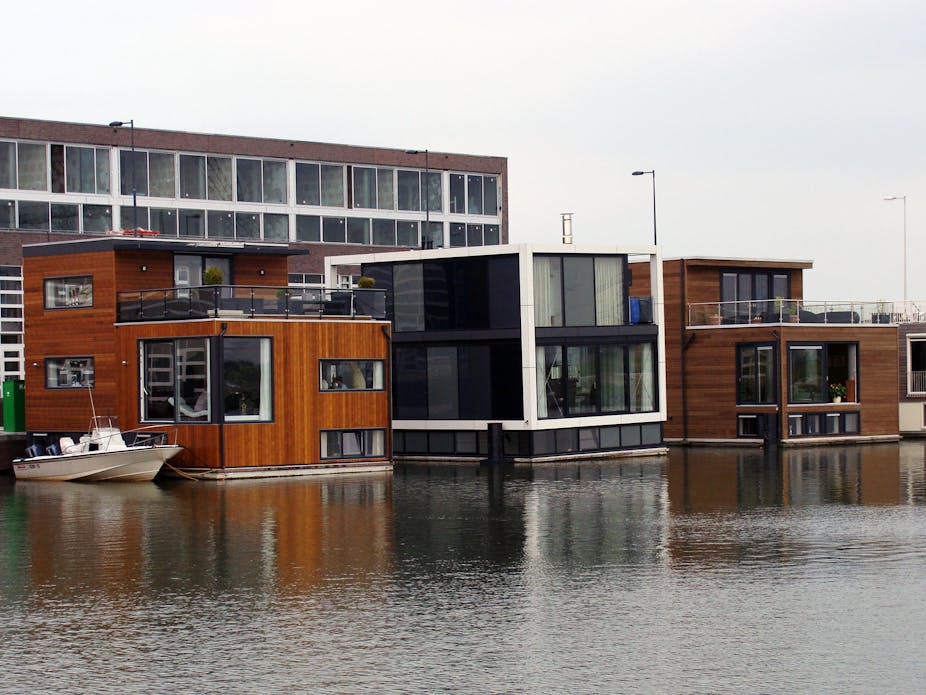We’ve been told to get used to flooding. Whether or not the latest floods were caused by climate change, this winter has reminded us that floods are and will continue to be a fact of human existence, especially if we continue to build on flood plains and due to increased extreme weather events as predicted in a changing climate.
The good news is that living with flooding is already a way of life for much of the world. The Netherlands for example has more than half its landmass below sea-level and building techniques there can teach us how to adapt where we live and to work with water, rather than against it.
We can do this with a combination of improving the way we manage the water system, the amount that we build and the way that we build. We should build less, not more, in flood risk areas and increase the amount of space we give to water storage. This means more green spaces, storing water and permeable surfaces.
And, if we do build in flood risk areas, there are many designs for flood resilient buildings we can use. Here’s an outline of how we can adapt existing buildings and build new ones differently to protect and minimise damage to property (and life) when flooding happens.
Flood the basement, save the home
Architects such as Baca specialise in flood risk designs. In the UK, especially on new developments in the Thames Estuary, we tend to favour “sacrificial ground floors”. This constitutes a building with a raised ground floor, where residential areas on the first floor. The basement – which can be used for storage or as a car park in times of no flooding – is there to contain water when it floods and protect the residential areas from water damage.

This design is suitable in areas that have a low to medium probability of flooding and has the drawback of having to sacrifice the basement when it floods. The space has limited uses such as for storage and the contents will have to be moved above flood risk level in the event of flooding.
Stilt life
Building on stilts is suitable in high flood probability zones and is more common in the Netherlands. This structure is useful in areas liable to a lot of flooding and particularly coastal areas. Added protection is still needed, however, from breakwaters to prevent debris damaging the stilts.

Urban environments are less suitable to stilt structures. The area underneath the stilts is hard to manage and use effectively. Nothing can really grow under them so it’s difficult to make the area into a public space. A lack of surveillance and ownership of the area can cause security issues in an urban environment. Erecting buildings on stilts also creates the need for ramps, lifts and aerial walkways – all of which are tricky in urban areas.
Float on
Floating buildings are another option, but may not be suitable for much of the UK, as they are built directly onto water. They use special polystyrene slabs that are covered in concrete for the base of the structure. As the water level rises, the ground floor moves with it, up to around five and a half metres. This method is tested in the Netherlands – they even built a floating greenhouse.

Building on water avoids the need to reclaim land and floating structures are suitable for areas with a high risk of flooding. Connected to a floating pier, smaller buildings of two storeys are most suitable for this. They can still be connected to services using pipework that is waterproof and flexible to allow for the vertical movement of the building.
Waterproofing
Another way of making buildings more flood proof is to ensure minimal damage occurs to properties by “wet-proofing” them. This may be achieved through the use of water-resistant materials, for example concrete or tiles for floors, and more robust walls and fixtures. Electrical controls, cables and appliances should be placed higher than the normal, usually above one metre from the ground. This can be done in all areas that may potentially flood.

As well as new building in the future bearing in mind these options, most existing structures can be wet-proofed. This means they are designed with possible future flooding in mind and result in only minimal damage to the property should this happen.
The exact timing of flooding is unpredictable, but the question of it taking place cannot be ignored and it’s time to start implementing more of these flood-proofing measures.
These, and many more, can be easily incorporated into current building procedures. If the right foresight and planning are given, we can have flood-resistant buildings that aid mitigation efforts and, if need be, support the future adaptation of our cities for years to come.
This article is derived from my book The Environmental Design Pocketbook and chapter, “Future-proofing London” in Sarah Bell and James Paskins’ Imagining the Future City: London 2062.

